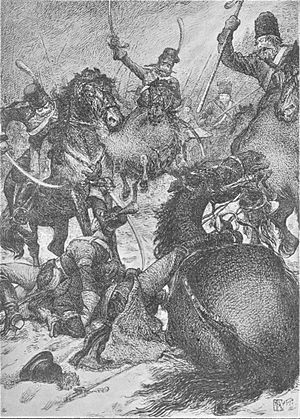Battle of Pyhäjoki facts for kids
Quick facts for kids Battle of Pyhäjoki |
|||||||
|---|---|---|---|---|---|---|---|
| Part of the Finnish War | |||||||
 Öfverste Löwenhjelms tillfångatagande, by Nils Kreuger |
|||||||
|
|||||||
| Belligerents | |||||||
| Commanders and leaders | |||||||
| Strength | |||||||
| 2,000–2,500 | 1,300 | ||||||
| Casualties and losses | |||||||
| 183 killed, wounded or captured | 100–150 killed, wounded or captured | ||||||
The Battle of Pyhäjoki was a small but important fight during the Finnish War (1808–1809). It happened on April 16, 1808, in a place called Pyhäjoki in Northern Ostrobothnia, Finland. This battle was part of a larger retreat by the Swedish army as the Russian army advanced. The cold winter made fighting difficult. This battle was one of the first clashes after the Swedish army stopped its main retreat.
Contents
The Finnish War Begins
The Finnish War was fought between Sweden and the Russian Empire. It lasted from 1808 to 1809. The war was mainly about who would control Finland. At the start of the war, Russian forces quickly moved into Finland. This forced the Swedish army to pull back towards the north.
The Russian Advance
As the Swedish army retreated, the Russian army followed closely behind. The Russians took control of large parts of Finland. A group of about 1,300 Russian soldiers, led by Yakov Petrovich Kulnev, was at the front of the Russian army. This group was called the "vanguard." Their job was to chase the Swedish forces.
Chasing the Swedes
Kulnev's vanguard caught up with the Swedish army's "rearguard" near a village called Ypperi. The rearguard is the part of an army that protects the main force from behind during a retreat. Small fights, called "skirmishes," happened all the way from Ypperi to Pyhäjoki.
The Battle at Pyhäjoki
When the fighting reached Pyhäjoki, the Swedish army decided to make a brief stand. They wanted to slow down the Russian advance. The Swedish commander, Wilhelm Mauritz Klingspor, had about 2,000 to 2,500 soldiers ready to fight. However, because they were retreating, only one group of soldiers could fight the Russians at a time.
Swedish Commanders and Orders
During the battle, General Klingspor gave orders to his officers, von Döbeln and Gripenberg. He told them to continue the retreat. This was part of the original plan for the Swedish army. Even though the Swedes fought hard, their main goal was to keep moving back in an organized way.
Casualties and Outcome
The Swedish soldiers managed to slow down Kulnev's attack. However, they lost 183 men. These losses included soldiers who were killed, wounded, or captured. Among those captured was a high-ranking officer named Gustaf Löwenhielm. The Russian forces, led by Kulnev, lost about 71 men just at Pyhäjoki. If you add the losses from the earlier skirmishes from Ypperi to Pyhäjoki, their total losses were probably around 100 to 150 men. In the end, the Battle of Pyhäjoki was a victory for the Russian army.

